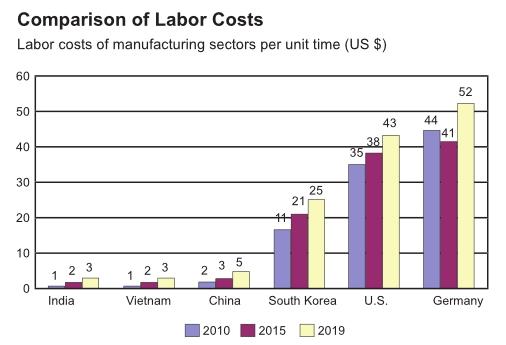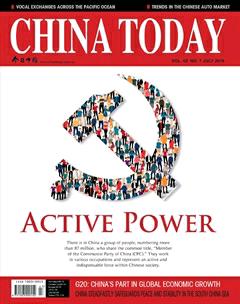China’s Innovation Benefits the World
By LI GANG

THE strategy of innovation-driven develop- ment implemented in China is expected to present opportunities to transform and update the nations economy, while also improving quality and effectiveness, yet also giving a fillip to the sluggish world economy.
Chinas Innovation from Global Perspectives
In The China Effect on Global Innovation, McKinsey Global Institute (MGI) evaluates the overall innovation capacity of Chinas enterprises. Identifying four archetypes of innovation, namely, science-based, engineeringbased, customer-focused, and efficiency-driven, the research measures Chinese companies innovation levels by reviewing the share of global revenue and profi t captured by Chinese companies in certain industries.
The MGI analysis indicates that Chinese companies show the greatest strengths in markets that require customer-focused innovation. Driven by considerable sales in the domestic market, Chinese fi rms across sectors such as household appliances (in which they account for 39 percent of global revenue), Internet software (15 percent), and consumer electronics (10 percent) take the lead among their global peers in respect of customerfocused innovation.
Furthermore, efficiency-driven innovation increases the value added to Chinese products and consolidates the countrys position as a preeminent global manufacturing hub. However, progress in Chinese engineering-based innovation is moving at different speeds in different markets. While several industries, such as high-speed rail, wind power and telecommunications equipment, have seen rapid growth, innovation capacity in such sectors as autos and medical devices still lags. China has yet to catch up with developed countries in science-based innovation.
In general, the environment and capacity for innovation constantly advance as the country progresses economically. China ranked 29th among 141 economies around the world in the Global Innovation Index 2015– Effective Innovation Policies for Development, copublished by Cornell University, INSEAD, and the World Intellectual Property Organization, displaying a narrower gap with developed countries and outperforming its de- veloping peers.
Today, our life is influenced by science and technology in every conceivable way. Scientifi c and technological innovation and development have greatly improved peoples lives. In China, a major developing country with a large population, technological innovation is pivotal in changing peoples lives. From the 1950s to the 1970s, bicycles, sewing machines, watches and radios were the most sought-after commodities in China. During this same period in developed countries, however, demand for consumer goods had already advanced to a level beyond mere contentment with relatively simple, yet durable goods. Today, as technologies and innovation maintain their advance in China, high-end consumer goods such as computers, smart phones and automobiles have gained in popularity. Statistics from the United Nations Development Program indicate that saturation by mobile phones and the Internet had reached 92.3 percent and 49.3 percent respectively by 2015. In a sense, science, technology, and innovation are making Chinese peoples lives ever better.
The improvement in Chinas innovation capacity greatly benefits from the countrys enormous market, abundant labor resources, and open economic policy, as well as the emerging trend whereby commercialization of inventions is becoming swift, while costs are comparatively low. Such advantages may also facilitate investment by overseas companies in China, so to speed up commercialization of the fruits of their innovation, while also beefing up their innovative capacity and competitiveness in the market.
Inexhaustible Driving Force of a Vast Consumer Market
Chinas consumer market – already enormous and ever on the increase – generates endless impetus for enterprise innovation, since booming consumer demand impels companies to commercialize the fruits of their innovation and scale up their manufacturing processes. The domestic consumer market is expanding in China and displaying the momentum of a rising demand in the wake of economic development and consequent in-creases in disposable income. China has become a huge consumer market for smart phones, with 750 million users – 4.2 times as many as in the U.S., and there are 650 million Internet users in China – 420 million more than in the U.S. China is moreover the worlds largest consumer market for PCs, air conditioners, fridges, microwave ovens, and household washing machines. Relying on this large market, Chinese companies such as Baidu, Alibaba, Tencent, and Haier have rapidly become leaders, not only in the local market, but also in the world, in the fields of, respectively, Internet searches, e-commerce, Internet games, and household appliances. This thriving market demand in turn also benefits overseas investors in China and stimulates their growth. For example, confronted by falling demand for small household appliances in developed countries, Phillips adjusted its strategy to relocate the production headquarters of a vacuum cleaner, juicer and electric rice cooker to China. Its sales of small household appliances have attained remarkable achievements in the robust Chinese market, with an increase of 56 percent in 2014 over 2012.
Rich Labor Resources, Lower Innovation Costs
Manpower is a decisive factor in manufacturing and creation. Despite the potential challenges posed by an aging population, China remains a country with an abundance of labor. At present, a total of 150 million industrial workers are at work in Chinas manufacturing sector, outnumbering the figures for the U.S. (14 million), Japan(nine million), and South Korea (four million). In addition, a considerable number of high-level talents offer intellectual support for enterprises to engage in innovation, while saving on labor costs. In 2013, 28,700 persons in China obtained their doctorate in science or engineering– a figure that stands at the worlds apex.
Although Chinas labor costs have been on an upward trend in recent years, these are still lower than those of developed countries. MGI estimates that labor costs in Chinas manufacturing sector will rise from US $2 per hour in 2010 to US $5 per hour in 2019. Though a 2.5-fold increase is no minor change, labor costs in China remain merely 11.6 percent of U.S.s costs, and 9.6 percent of Germanys (See figure). Thanks to a labor force that is large in number, flexible within the market, cost-effective and well-qualified, Chinas enterprises are capable of saving on the costs of innovation and accelerating their innovative practices.
Innovative Development Strategy Brings Confidence and Impetus
Innovation occupies the primary position of new growth concepts announced in Chinas 13th Five-Year Plan – innovative, coordinated, green, open and shared development. It is expected to become a new driving force for the countrys economic growth against the backdrop of the “new normal.” The idea of innovative development will exert enduring influence on Chinas future economic development and bring confidence and impetus to the depressed world economy.
While revealing that the Chinese economy would expand by 6.5 percent in 2016 and 6.2 percent in 2017, both up 0.2 percentage points from its latest world economic outlook, the International Monetary Fund (IMF) has lowered its forecast for the growth of other major economies. The U.S. economy is expected to grow 2.4 percent in 2016, and 2.5 percent in 2017, down 0.4 and 0.3 percentage points respectively from its previous forecasts. The IMF also predicts that the Eurozone will grow 1.5 percent this year, and 1.6 percent next year, both down 0.2 percentage points. Japan will grow 0.5 percent in 2016, but suffer an economic contraction of 0.1 percent in 2017, both down 0.5 percentage points. The IMF has raised the outlook for Chinas economic growth based on the countrys economic strength and its mid- to long-term economic development strategy. As the worlds second largest economy, Chinas influence on the global economy is massive. In 2015, China claimed 17.1 percent of the worlds economic aggregate and 11.4 percent of the worlds total export volume. The IMF predicts that Chinas annual contribution to world economic growth will be over 25 percent in the years 2016 to 2020.
As a strategic outline for Chinas mid- to long-term economic and social development, the 13th Five-Year Plan highlights innovative development strategies and supply-side structural reform. Innovation and reform will facilitate Chinas traditional industries transformation and upgrading, while also stimulating the transition of economic growth models from investment-driven to consumption-driven. Transformation of economic growth models, upgrade of the public consumption structure, optimization of the industrial structure, and new-style urbanization are expected to profit China itself and generate new investment opportunities for global enterprises. An open and inclusive Chinese economy offers a platform for companies worldwide to realize innovative development.

